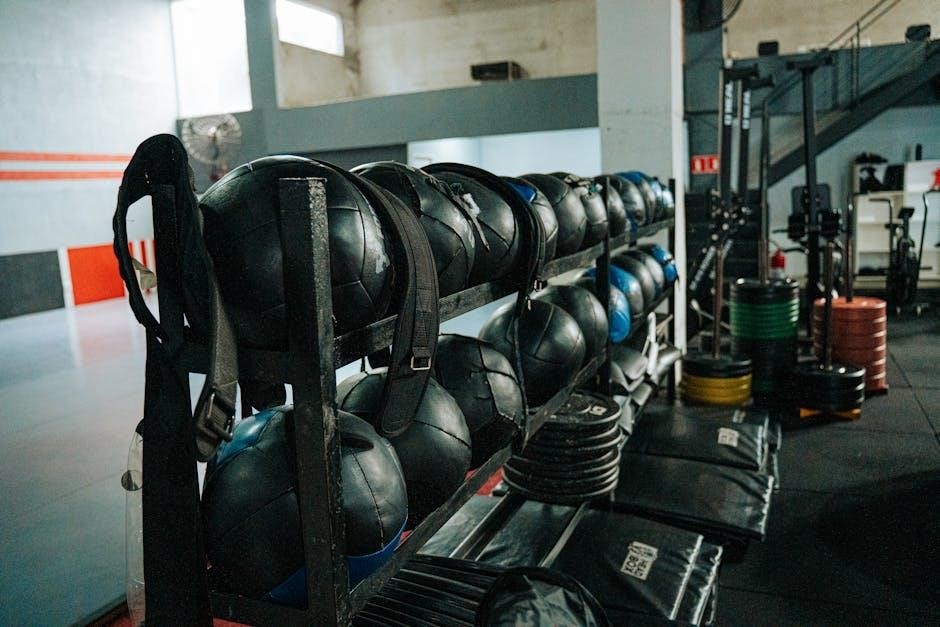
Mike Mentzer, a legendary bodybuilder, revolutionized training with his High-Intensity Training (HIT) philosophy, emphasizing brief, intense workouts to achieve maximum muscle growth and strength efficiently.
1.1 Who is Mike Mentzer?
Mike Mentzer was a renowned American bodybuilder, known for developing the Heavy Duty training system. A former Mr. Universe and Mr. Olympia competitor, he revolutionized bodybuilding with his high-intensity, low-volume approach. Mentzer’s philosophy, influenced by Arthur Jones, emphasized training to muscle failure for optimal results. His methods gained popularity in the 80s and 90s, influencing notable bodybuilders like Dorian Yates. After retiring from competition in 1980, Mentzer dedicated his life to promoting his training principles through books and lectures, leaving a lasting legacy in the fitness world.
1.2 The Evolution of High-Intensity Training (HIT)
HIT, pioneered by Arthur Jones, was further developed by Mike Mentzer into the Heavy Duty system. This approach focuses on short, intense workouts with minimal volume, prioritizing maximum effort. Mentzer’s HIT involves performing one working set to muscle failure, typically in the 6-9 rep range. Over time, HIT evolved to include techniques like rest-pause and progressive overload, enhancing effectiveness. Its principles, such as training to failure and emphasizing intensity over volume, have influenced modern training methods and remain popular among bodybuilders seeking efficient muscle growth and strength gains.
1.3 Why Mike Mentzer’s Workout Gained Popularity
Mentzer’s workout gained popularity due to its simplicity and efficiency. His HIT system, emphasizing brief, intense sessions, appealed to those seeking results without spending hours in the gym. The focus on one-set training to failure and minimal volume resonated with bodybuilders looking for a time-effective approach. Additionally, its success with notable athletes like Dorian Yates and its alignment with scientific principles of muscle hypertrophy further boosted its appeal, making it a preferred choice for many in the fitness community.

The Core Principles of Mike Mentzer’s High-Intensity Training (HIT)
Mentzer’s HIT focuses on training to muscle failure, prioritizing intensity over volume, and ensuring adequate rest for recovery, optimizing muscle growth and strength efficiently.
2.1 Training to Muscle Failure
Training to muscle failure is central to Mike Mentzer’s HIT philosophy. It involves pushing muscles to the point where no additional reps can be completed with proper form. This approach maximizes muscle stimulation and ensures that each set is as effective as possible. By reaching failure, the muscles are fully engaged, promoting significant growth and strength gains. Mentzer emphasized that this method is key to achieving results efficiently without unnecessary volume.
2.2 The Importance of Intensity Over Volume
Mentzer’s philosophy prioritizes intensity over volume, arguing that high-intensity workouts yield better results than prolonged, high-volume training. By focusing on fewer, more intense sets, individuals avoid overtraining and optimize recovery. This approach ensures that each exercise is performed with maximum effort, leading to greater muscle stimulation and growth. Mentzer believed that intensity, not the number of sets, drives progress, making his method both efficient and effective for achieving muscle hypertrophy and strength gains.
2.3 The Role of Rest and Recovery
Mentzer emphasized that rest and recovery are critical components of his HIT system. He advocated for longer recovery periods, typically 4-7 days between muscle group workouts, to allow muscles to repair and grow. Overtraining was a concern, as excessive volume could hinder recovery and growth. By prioritizing rest, individuals ensure their bodies adapt to the intense stress of workouts, leading to optimal results. This approach contrasts with traditional high-frequency training, highlighting the importance of recovery in achieving muscle development.
The Heavy Duty Training System
Mentzer’s Heavy Duty system focuses on short, intense workouts with minimal volume, emphasizing maximum effort and recovery to stimulate muscle growth and strength efficiently.
3.1 What is Heavy Duty Training?
Heavy Duty Training, developed by Mike Mentzer, is a high-intensity, low-volume system designed to maximize muscle growth and strength. It involves brief, infrequent workouts where each muscle group is trained to failure with one working set of 6-9 reps, using heavy weights. The focus is on intensity over volume, with extended recovery periods of 4-7 days between sessions for the same muscle group. This approach aims to optimize results while minimizing time spent in the gym, making it both efficient and demanding.
3.2 Key Differences from Traditional Training Methods
Heavy Duty Training differs from traditional methods by prioritizing intensity over volume, with fewer sets and exercises. Unlike conventional approaches that emphasize high-volume workouts, Mentzer’s system focuses on one working set to failure, minimizing training time. It also advocates for longer recovery periods of 4-7 days per muscle group, contrasting with the higher frequency seen in traditional training. This approach emphasizes efficiency and avoids overtraining, making it a distinct alternative to the volume-focused methods popularized by bodybuilders like Arnold Schwarzenegger.
3.3 The Science Behind Heavy Duty Training
Mentzer’s Heavy Duty Training is rooted in physiological principles, focusing on recruiting fast-twitch muscle fibers for maximum hypertrophy. By training to failure, muscles experience micro-tears, triggering repair and growth. The system leverages progressive overload, gradually increasing weight to challenge muscles and promote continuous adaptation. This approach aligns with the scientific concept of muscle protein synthesis, where intense stress stimulates growth. The emphasis on recovery ensures muscles rebuild stronger, supporting long-term strength and size gains. This scientifically backed method maximizes efficiency and results in less time compared to traditional training.

Mike Mentzer’s Workout Structure
Mentzer’s workouts feature one-set training with maximum effort, targeting muscle failure in 6-9 reps. He trains each muscle group once weekly, allowing 4-7 days recovery, ensuring efficiency and effectiveness.
4.1 One-Set Training Philosophy
Mentzer’s one-set training philosophy focuses on performing a single working set per exercise to absolute muscle failure. This approach emphasizes intensity over volume, ensuring maximum muscle stimulation. By training with maximum effort, individuals achieve optimal results without unnecessary additional sets; Mentzer believed that hitting the muscle once with extreme intensity was more effective than multiple sets, reducing training time and preventing overtraining. This philosophy, central to his Heavy Duty system, has influenced many, including Dorian Yates, who credited it for his success, proving its effectiveness in achieving significant muscle growth and strength gains.
4.2 Exercise Selection and Muscle Groups
Mentzer’s Heavy Duty system prioritizes compound exercises targeting multiple muscle groups simultaneously, such as squats, deadlifts, and bench presses. These movements recruit the maximum number of muscle fibers, enhancing efficiency. Each workout is structured to address major muscle groups like chest, back, shoulders, legs, and arms, ensuring comprehensive development. Mentzer advocates for a balanced approach, avoiding isolation exercises unless necessary, to maintain focus on overall muscle growth and functional strength. This strategic selection ensures an effective and time-efficient training program.
4.3 Training Frequency and Recovery Periods

Mentzer’s Heavy Duty system advocates training each muscle group once every 4-7 days, allowing ample recovery time. This approach prevents overtraining and ensures muscle repair, crucial for growth. With only two workouts per week, each session targets different muscle groups, enabling maximum intensity without interference. Recovery periods are tailored to individual fatigue, often requiring 48-72 hours before retraining the same muscles. This structured frequency balances intensity and rest, optimizing muscle development and overall performance.

The Role of Progressive Overload in HIT
Progressive overload in HIT involves gradually increasing weight or reps to challenge muscles, ensuring continuous strength and hypertrophy gains through intense, focused efforts.
5.1 How to Implement Progressive Overload
Implementing progressive overload in HIT involves gradually increasing weight or resistance to challenge muscles. Start by assessing your current strength levels to determine a baseline weight. Gradually add small increments (e.g., 2.5-5lbs) to the bar each workout, ensuring proper form. For advanced lifters, techniques like rest-pause or cluster sets can enhance overload. Consistency is key; aim to increase weight or reps weekly. Track progress to ensure steady gains, and prioritize full range of motion to maximize muscle engagement and avoid injury.
5.2 The Importance of Tracking Progress
Tracking progress is essential for HIT’s success, allowing you to monitor strength gains and ensure adherence to progressive overload. Maintain a workout log to record weights, reps, and recovery times. Regularly assess improvements in muscle size and strength. Use photos and measurements to visually track changes. Over time, this data helps refine your training and nutrition, ensuring optimal results. Without tracking, it’s challenging to gauge progress or adjust your regimen effectively, making consistency and improvement difficult to achieve. Regular assessment keeps you motivated and accountable in your training journey.
5.3 Avoiding Injury with Proper Form
Proper form is crucial in Mike Mentzer’s HIT to prevent injuries and maximize muscle engagement. Emphasize controlled, full-range movements, avoiding sloppiness. Focus on each rep with intent, ensuring muscles work as intended. Incorporate rest-pause techniques and strict form to maintain intensity safely. Neglecting form can lead to injuries and hinder progress. By prioritizing proper form, you protect your joints and ensure long-term training consistency. This approach not only enhances safety but also optimizes results, making it a cornerstone of Mentzer’s philosophy.

Nutrition and Supplementation for HIT
Nutrition is vital for HIT success. Focus on a calorie-surplus diet rich in protein, carbs, and fats to fuel muscle growth and recovery. Supplements like protein shakes and creatine can enhance results and aid recovery, aligning with Mentzer’s principles for optimal performance and muscle development.
6.1 Dietary Requirements for Muscle Growth
Adequate nutrition is crucial for muscle growth during HIT. Focus on a calorie-surplus diet with sufficient protein (1.6-2.2g/kg of body weight) to support muscle repair and hypertrophy. Emphasize complex carbohydrates for energy and healthy fats for hormone production. Stay hydrated and prioritize whole, nutrient-dense foods over processed options. Avoid excessive sugar and maintain a balanced macronutrient ratio to optimize recovery and growth, aligning with Mentzer’s principles for sustainable muscle development.
6.2 The Role of Protein in Recovery
Protein is essential for muscle recovery and growth in HIT. It provides amino acids necessary for repairing and rebuilding muscle tissue damaged during intense workouts. Aim for 1.6-2.2g of protein per kilogram of body weight daily, spread across meals. High-quality sources like lean meats, fish, eggs, and dairy are ideal. Protein shakes can supplement dietary intake, ensuring adequate recovery and muscle synthesis, which is critical for the high-intensity, low-volume training advocated by Mentzer.
6.3 Supplements to Support HIT Workouts
Supplements like creatine, BCAAs, and L-Glutamine can enhance recovery and performance in HIT. Creatine boosts strength and endurance, while BCAAs reduce muscle soreness. L-Glutamine aids muscle recovery and immune function. Nitric oxide boosters improve blood flow, enhancing workout intensity. These supplements complement the high-intensity, low-volume training style, helping to optimize results. However, they should not replace a balanced diet and proper rest, which are foundational to HIT success.
Mental and Psychological Aspects of HIT
HIT demands mental toughness, focus, and discipline. Overcoming training plateaus requires resilience, while consistency ensures long-term success.
7.1 Building Mental Toughness
Mental toughness is crucial for HIT, as it demands pushing through intense discomfort and fatigue. Mike Mentzer emphasized that overcoming physical limits requires resilience and unwavering focus. HIT’s brief but brutal workouts train the mind to endure stress, fostering determination and discipline. By consistently applying maximum effort, individuals develop the psychological strength to push beyond perceived boundaries, essential for long-term success in HIT and beyond.
7.2 Overcoming Training Plateaus
Mentzer’s HIT system addresses plateaus by adjusting intensity and volume. He advocated for progressive overload, ensuring each workout challenges muscles beyond previous limits. Proper rest and recovery are emphasized to avoid stagnation. By refining exercise form and strategically increasing weight, trainees break through plateaus, maintaining continuous progress. This systematic approach ensures sustained growth, keeping workouts effective and engaging.
7.3 The Importance of Consistency
Consistency is crucial in Mike Mentzer’s HIT system, as sustained effort ensures progressive overload and muscle adaptation. Regular application of high-intensity workouts, paired with proper recovery, fosters continuous muscle growth and strength gains. Mentzer emphasized that erratic training undermines progress, while steadfast commitment to the program yields long-term results. Consistency reinforces discipline and mental resilience, essential for overcoming challenges and achieving success in HIT.

Criticisms and Controversies Surrounding HIT
Mike Mentzer’s HIT faced criticism for being too extreme, with some arguing its low-volume approach could limit muscle development. Others questioned its suitability for all fitness levels.
8.1 Common Misconceptions About HIT

Many believe HIT involves only one set per exercise, but this overlooks progressive overload and intensity adjustments. Some misconceptions include the idea that HIT neglects recovery or is overly extreme, when in fact, it emphasizes rest and muscle failure, not volume. Critics also argue HIT is too intense for beginners, but proper form and gradual progression can make it accessible. These misconceptions often stem from misunderstanding HIT’s focus on efficiency and intensity over traditional high-volume training methods.
8.2 Comparisons with Traditional Training Methods
HIT differs significantly from traditional training by prioritizing intensity over volume. Unlike conventional methods requiring multiple sets and long sessions, HIT advocates for shorter workouts with maximum effort. While traditional approaches often focus on endurance and muscle endurance, HIT targets rapid muscle fiber stimulation and failure. This contrast leads to debates about efficiency, with HIT supporters arguing for faster results and critics emphasizing the benefits of higher volume for hypertrophy and muscular endurance in the long term.
8.3 The Role of Individualization in Training
Mike Mentzer’s HIT emphasizes individualization, recognizing that each person’s genetic makeup and recovery capacity vary; Unlike one-size-fits-all programs, HIT encourages tailoring workouts to personal limits, focusing on intensity and recovery rather than generic set and rep schemes. This approach allows trainees to optimize progress by adjusting weights, reps, and rest periods based on their unique needs and responses. Individualization ensures that workouts remain effective and sustainable, preventing overtraining and enhancing long-term success.
The Influence of Mike Mentzer on Modern Training
Mike Mentzer’s HIT philosophy revolutionized modern training, inspiring efficient, intensity-focused workouts. His principles, adopted by legends like Dorian Yates, continue to shape contemporary bodybuilding and fitness routines.
9.1 How HIT Has Evolved Over Time
High-Intensity Training (HIT) has evolved significantly since Mike Mentzer’s era. Modern adaptations incorporate scientific advancements, such as periodization and recovery techniques, while maintaining the core principle of maximizing intensity. Trainers now often blend HIT with other methods, creating hybrid programs that cater to diverse fitness goals. The rise of rest-pause sets and blood flow restriction training are examples of how HIT continues to adapt, ensuring its relevance in contemporary fitness landscapes.
9.2 Notable Bodybuilders Influenced by Mentzer
Dorian Yates, a six-time Mr. Olympia winner, was heavily influenced by Mike Mentzer’s HIT principles, incorporating them into his training regimen. Yates often credited Mentzer’s philosophy for his success, particularly in achieving intense workouts with minimal volume. Additionally, Ray Mentzer, Mike’s brother, also adopted and promoted the HIT system, further spreading its influence. Mentzer’s ideas have inspired a generation of bodybuilders, proving the lasting impact of his high-intensity approach on the sport.
9.3 The Legacy of Mike Mentzer in Bodybuilding
Mike Mentzer’s legacy in bodybuilding is profound, as he transformed traditional training methods with his HIT philosophy. His books and teachings have inspired countless athletes, emphasizing efficiency and intensity over volume. Mentzer’s approach continues to influence modern training systems, proving that less can be more when maximizing muscle growth and strength. His impact remains significant, shaping the way many approach resistance training and recovery, ensuring his contributions to bodybuilding endure for generations.
Where to Find Mike Mentzer’s Workout PDF
Mike Mentzer’s workout PDFs are available on his official website, fitness platforms like Fitness Volt, and through his books, ensuring authentic access to his HIT system.
10.1 Official Sources and Publications
Mike Mentzer’s workout PDFs are available through his official website and publications. His books, such as High-Intensity Training the Mike Mentzer Way and Heavy Duty, provide detailed workout plans. The Heavy Duty website also offers resources, ensuring authenticity and comprehensive guidance on his training philosophy. These official sources are essential for those seeking accurate information on implementing his HIT system effectively.
10.2 Reliable Online Platforms for HIT Resources
Reliable online platforms for HIT resources include Fitness Volt, which offers detailed guides and articles on Mike Mentzer’s training philosophy. Additionally, platforms like Amazon and eBay provide access to Mentzer’s books in PDF or eBook formats. Websites dedicated to bodybuilding and fitness, such as Reddit forums and specialized training communities, often share verified HIT resources. Always ensure the credibility of the source to avoid misleading or unverified information.
10.3 Avoiding Unverified or Misleading Information
To ensure authenticity, verify resources from trusted sources like Mike Mentzer’s official website or reputable fitness platforms. Be cautious of unofficial PDFs or guides claiming to represent his methods. Cross-check information with Mentzer’s published books or credible websites like Fitness Volt. Avoid forums or social media posts lacking proper citations or peer reviews. Always prioritize official publications and well-known fitness authorities to access accurate and reliable HIT content.
Mike Mentzer’s HIT philosophy revolutionized bodybuilding with its efficiency and intensity. His methods remain influential, offering a proven path to muscle growth. Seek official sources for authentic guidance.
11.1 The Effectiveness of Mike Mentzer’s Workout
Mike Mentzer’s workout, based on high-intensity training, has proven effective for muscle growth and strength. By focusing on maximum effort and minimal volume, it ensures efficient progress. Its emphasis on training to failure and adequate recovery aligns with scientific principles of hypertrophy. Many athletes, including Dorian Yates, attribute their success to Mentzer’s methods, highlighting its validity. The approach challenges traditional high-volume training, offering a time-efficient alternative that prioritizes quality over quantity, making it a sustainable choice for dedicated individuals seeking results without excessive gym time.
11.2 The Future of High-Intensity Training
High-Intensity Training (HIT) continues to gain traction as a sustainable and efficient approach to fitness. Its focus on short, intense workouts aligns with modern lifestyles, appealing to those seeking maximal results in minimal time. As fitness science evolves, HIT’s principles—such as progressive overload and periodization—are being integrated into mainstream training programs. The method’s emphasis on quality over quantity ensures its relevance, making it a cornerstone of future training trends. HIT’s adaptability to individual goals and fitness levels further solidifies its place in the evolving landscape of strength and conditioning.
11.3 Final Thoughts on Implementing HIT
Implementing HIT requires discipline and a willingness to push beyond comfort zones. By focusing on intensity over volume, individuals can achieve remarkable gains in strength and muscle growth. Consistency is key, as is adequate rest and nutrition. HIT’s efficiency makes it ideal for those with busy lifestyles, offering a sustainable path to fitness. Embrace the philosophy, stay patient, and witness transformative results over time. Remember, less can be more when executed with precision and dedication.
Leave a Reply
You must be logged in to post a comment.